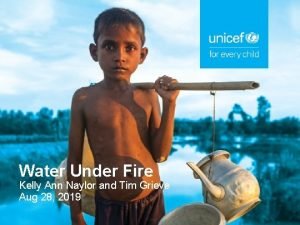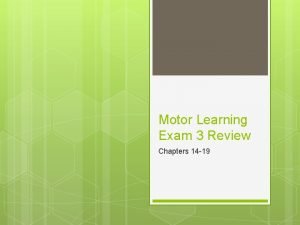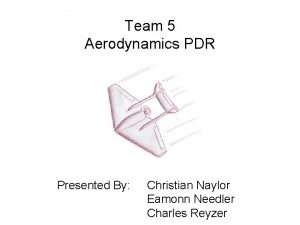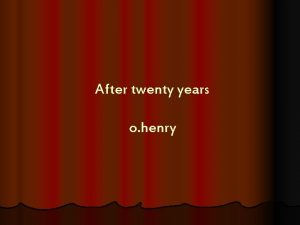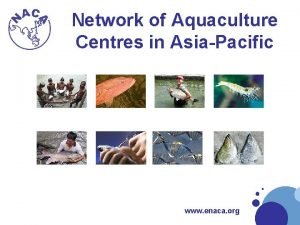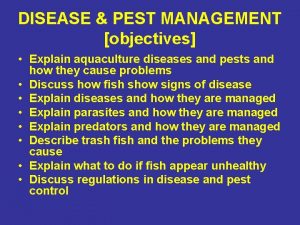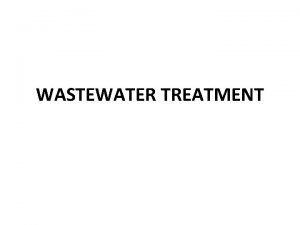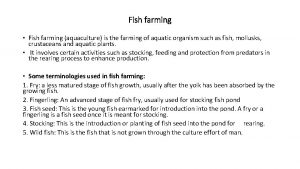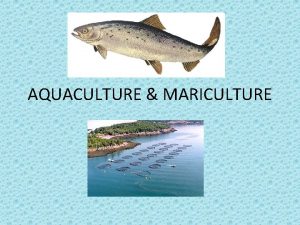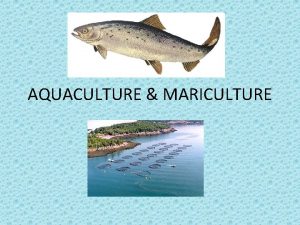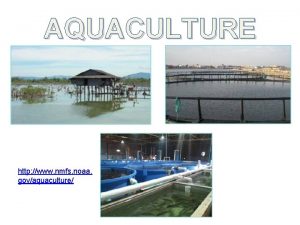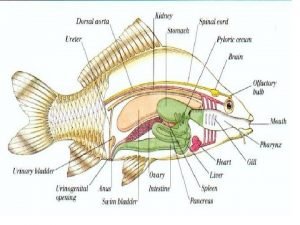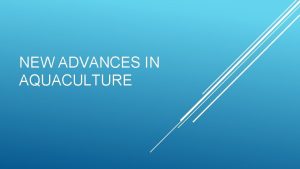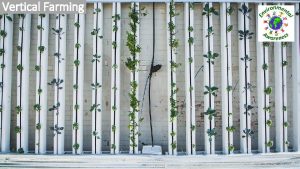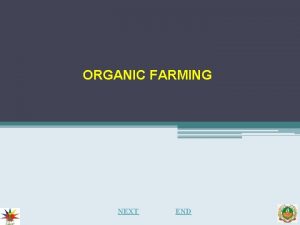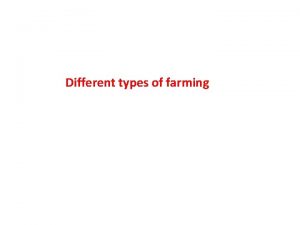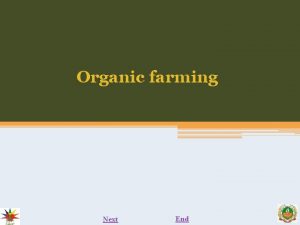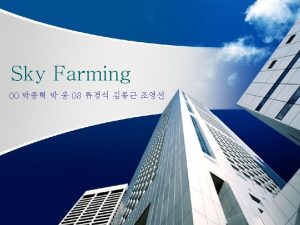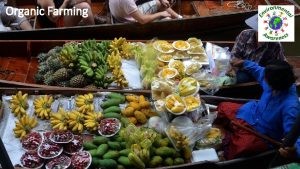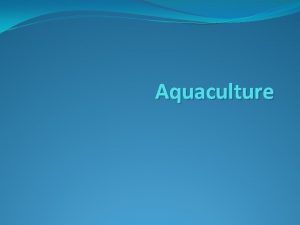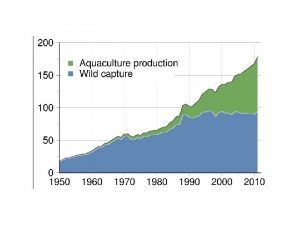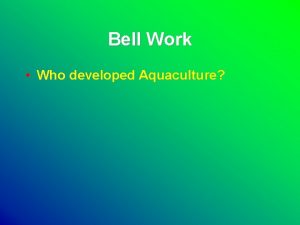Aquaculture farming 14 years after Naylor R paper


















- Slides: 18

Aquaculture farming, 14 years after Naylor, R. paper (Nature, 2000) G Fiore, Joint Research Centre of the EU Commission EU sustainable aquaculture project Workshop – Athens, 5/6 may 2014

JRC sites location • 8 Scientific Institutes + Brussels Headquarter • Located in Spain (IPTS), Italy (IPSC, IHCP, IES, ISM), Germany (ITU), The Netherlands (IET) and Belgium (IRMM)

Main JRC aquaculture research fields Spatial distribution of aquaculture sites Seafood market and trade Aquaculture and coastal communities FP 7 involvement (Aquatrace) EAPI project (European Aquaculture Performance Indicators) • LCAs studies on fisheries and aquaculture • Ecosystem based management approach to Fisheries and aquaculture (CFP) • • •

Naylor, R. L. and others (2000, Nature), 969 citations (2000/2014)

Main elements in Naylor paper • Increasing human population will result in an increase of the fish production [NB: + 23 Mt of fish protein by 2020 (Delgado)] • 87. 3% of the stocks is in one of the FAO risk categories (fully/over exploited, etc. ) • Increase of aquaculture production (FAO) moved from 32. 4 Mt (2000) to 59. 9 Mt (2009) with an average annual rate of 8. 8% in the last 3 decades (1980/2010)

Aquaculture risks (according to Naylor) • Potential damage to resources through habitat destruction • Waste disposal • Exotic species/pathogens invasions • FMFO requirements > potential contribution to collapse of fisheries rather than alleviation of pressure?

Naylor conclusions and possible solutions • Aquaculture potential contribution to fish supply diminished by use of FMFO (farming of carnivorous species) and possible impact on the environment (habitat, pollution, discharge) • Possible solutions: farming down the web (herbivorous diet, etc. ), reduction of FMFO use, integrated farming systems, ecological sound practice (escapees, siting of ponds, biosafety measures, recirculation of wastewater)

Sustainability, but at what level? • Look at the situation with a global perspective, rather than on a local level • Use of FMFO poses a general problem of use of protein sources, while the control of the environmental impact (for instance, discharge) is relevant al local level

14 years after Naylor paper • The development of the aquaculture farming is dealing with environmental concerns, not so stringent when other industrialized farming industries (beef, pork, etc. ) established (40 s’) • Looking at the improvements in the last years on a wider perspective would allow to detect some major changes.

Use of FMFO and major changes in the feed industry • World reduction fisheries: 18. 2 Mt (1976)>30. 2 Mt (1994)> 17. 9 Mt (2009) • Fishmeal: 50 Mt (1976)> 7. 48 MT (1994)> 5. 74 (2009), annual decrease of 1. 7% • Fish-oil: 1. 02 Mt (1976)> 1. 5 Mt (1994)> 1. 07 (2009) • Increase of byproducts for FMFO (25% according ti IFFO) Source: FAO (The state of World Fisheries and Aquaculture 2012)

Decrease of FM use Decline of the production to a predicted 3. 49 Mt (2020), due to a: a) better technology in feed production; b) better FCR (45/25 FM/FO in 1995 >< 18/12 in 2013) c) tighter quotas, better controls in UF This concerns farming systems of carnivorous species (i. e. the minority) Source: FAO (The state of World Fisheries and Aquaculture 2012)

Increase of freshwater farming (Naylor recommendation “farming down the web”) • Increase of freshwater in the last 30 years: from 50 to 62% while marine decreased from 42 to 30% (out of which 74. 5% are mollusc farming) Source: FAO (The state of World Fisheries and Aquaculture 2012)

Comparison with other segments • Moving from an analytical to a more holistic approach: it is important to compare the performance of aquaculture farming within the same production segment (fish protein production) in terms of impact as well as efficiency and with other animal production systems

Comparison with fisheries (LCA) Impact categories GWP (kg CO 2 eq. /ton) WPC (kg of losses per kg of caught cod) Energy (MJ/ton) EP (kg PO 4 eq. /ton) AP (kg SO 2 eq. /ton) Cod (NE Artic) 7, 600 0. 23> 0. 17 112, 000 12 53 NPPU (kg C/ton) 111, 000 Impact categories GWP (kg CO 2 eq. /ton) NPPU (kg C/ton) Energy (MJ/ton) EP (kg PO 4 eq. /ton) AP (kg SO 2 eq. /ton) Trout (recirculation system) 1, 602 21, 432 57, 659 17. 8 10. 5 Impact categories GWP (Kg. CO 2 eq. /ton) BRU (kg C/ton) CEU (MJ/ton) EP (kg PO 2 eq. /ton) AP (kg SO 2 eq. /ton) Tilapia (Intensive) 2, 220 2, 760 29, 300 48. 4 27. 5 Impact categories GWP (Kg. CO 2 eq. /ton) BRU (kg C/ton) CEU (MJ/ton) EP (kg PO 2 eq. /ton) AP (kg SO 2 eq. /ton) Salmon (net pen) 1, 530 101, 000 22, 600 5. 7 14. 3 Source: LCA scientific publications (several authors, JRC)

Comparison with fisheries (efficiency) • Efficiency of farmed versus wild: the production of 1 unit of predatory fish requires 10 Units of food (small pelagic fish) compared to 2 -5 units to produce a unit of farmed fish (Naylor) • This is because in a “controlled environment” fish would not spent energy to reach productive fishing grounds. In addition in the wild stock must invest greater efforts to catch the same amount of fish than in previous years

Comparison with other animal farming system (LCA limited to farm gate) Use of land, energy and highest GWP for the production of 1 kg of beef, followed by production of pork and poultry meat. Higher values (energy and climate change categories) than for intensive aquaculture farming. Impressive water footprint values. Animal species Beef Pork Poultry Land use (m 2/kg) (*) Fossil energy (MJ/kg) (*) Climate change (co 2/kg) (*) Water consumption (lt/kg)(^) 27/49 8. 9/12. 1 8. 1/9. 9 34/52 18/45 15/29 14/32 3. 9/10 3. 7/6. 9 14414 4907 3545 Source: (*) De Vries, M. and others (2010) and (^) Mekonnen, M. and others (2012)

Conclusion • If we really consider that aquaculture could play a substantial role in the context of the need to feed 9 billions of persons, then we should consider a wider set of elements, and compare all the impacts (also on the environment) in all food producing systems, in order to identify the best possible option(s). • Also for aquaculture, the main question still is:

Each (possible) solution should be substantiated by an accurate CAs
 After me after me after me
After me after me after me John 14:1-3
John 14:1-3 Ava naylor
Ava naylor Borious
Borious Ann naylor
Ann naylor Naylor and briggs hypothesis
Naylor and briggs hypothesis Naylor meaning
Naylor meaning Mean aerodynamic chord
Mean aerodynamic chord Naylor shine tables
Naylor shine tables Dr stephen naylor
Dr stephen naylor How long ago was four score and seven years
How long ago was four score and seven years Sheep years to human years
Sheep years to human years 300 solar years to lunar years
300 solar years to lunar years Literary devices in after twenty years
Literary devices in after twenty years After many years (duo nian yi hou)
After many years (duo nian yi hou) After twenty years by o henry
After twenty years by o henry Network of aquaculture centres in asia-pacific
Network of aquaculture centres in asia-pacific Aquaculture pest analysis
Aquaculture pest analysis Aquaculture water treataent factory
Aquaculture water treataent factory




